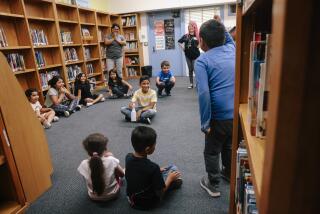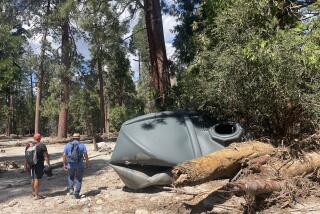Flu goes to camp; will it go to school next?
Hundreds of children have been sent home from summer camps across Southern California in recent weeks with flu-like symptoms, and camp counselors and directors are taking precautions to prevent the spread of the H1N1, or swine flu, virus in cabins and mess halls.
But officials say the sight of children arriving at sleep-away camps armed with the anti-viral medication Tamiflu is probably just a harbinger of what awaits schools in coming weeks as students move into dormitories, and elementary and secondary students begin classes.
Health officials predict a resurgence of the flu in the fall, and a vaccine effective against H1N1 is not expected to be available until long after the start of school.
School districts and universities are on alert, working with health officials to launch education campaigns, stockpile medical supplies and discuss worst-case scenarios.
State education officials are developing plans to provide lessons and meals for low-income children in case elementary and secondary schools close.
School closures would occur only by order of the superintendent or the county health department and only if so many children were sick that it was impractical to keep classes running, said Dr. Kimberly Uyeda, director of student medical services at the Los Angeles Unified School District.
UC campuses are stockpiling supplies, from paper masks and hand sanitizer to food and water. Officials are going over worst-case scenarios in case of campus-wide outbreaks. Officials are considering screening students for fever when they check into dorms.
“If we prepare for the worst, then we’re going to get a better outcome,” said Grace Crickette, chief risk officer for the University of California.
For now, sleep-over camps provide a look at what schools may face.
Before children are allowed to board camp-bound buses, nurses check temperatures and medical histories, hoping to ensure they are flu-free. Visitors days have been canceled at some camps, and makeshift infirmaries were created in some dining halls and lawns. High-fives and hand-holding are out, replaced by fist bumps and elbow-linking. Hand sanitizer is everywhere.
“We’re all getting habitual with our Purell,” said Jordanna Flores, executive director of Camp Alonim in Simi Valley, which has sent 160 children home in recent weeks. Many have since recovered and returned to camp.
Flu symptoms have been mild, but the virus is highly contagious, particularly when children are in close proximity.
Some organizations that cater to children with health issues, including the American Lung Assn. and the Muscular Dystrophy Assn., canceled camps because of concerns about the virus.
“It’s not worth the risk,” said Bob Mackle, a spokesman for the Muscular Dystrophy Assn. “It was a heartbreaking decision for us, and it was a tough decision.”
Most camps remain open, according to the American Camp Assn. No organization has a complete list of outbreaks, but there have been anecdotal reports from across the country, notably in the Northeast, which has a deep tradition of sleep-away camps.
The California Department of Public Health has received reports of outbreaks at 16 camps in eight counties, though department officials suspect the number is higher.
At Camp Ramah in the Ojai Valley, 80 campers and staff members were sent home with flu-like symptoms in the first session; many have returned. Twenty-nine eventually tested positive for the flu, said Rabbi Daniel Greyber, the camp director. The camp canceled its annual visitors day, which typically attracts as many as 2,000 people, and instead brought in a petting zoo.
Once campers left, workers deep-cleaned the bunks, beds and bathrooms. The 600 campers attending the second session, which began Thursday, were advised to pack Tamiflu.
“We hope it’s a proactive thing that we can do to minimize the flu within the camp,” Greyber said.
Education is equally important. Greyber demonstrated proper coughing and sneezing etiquette (into the elbow or on the sleeve, not into the hands). Campers produced skits about “Swine ’09.”
But for some children who fell ill, the situation was traumatic.
At Camp Alonim, health center coordinator Cindy Petrak said some campers wept when they learned they would have to leave their healthy friends and siblings for seven days to recover.
“It felt like Ellis Island,” she said.
On a recent day, children lined up in an infirmary to have their temperatures taken. Parents of any who had fevers were called to pick them up. As many as 20 campers rested on a grassy lawn, sitting on white sheets with their luggage, waiting for their rides home.
Austin, a sixth-grader from Encino, had a fever and a sore throat when he was sent home. He said he was sad to miss bunk night, when his cabin-mates picked the evening activities. When he returned, he said, he was happy that friends noticed his absence. “They all recognized I was back,” he said.
Some camps have been spared, including Camp Paintrock and Blue Sky Meadow.
Camp Paintrock sends Los Angeles children to Wyoming for a four-week youth leadership development program. About half a dozen of the 60 campers had flu-like symptoms, but none tested positive for the flu.
Blue Sky Meadow, a science camp for Los Angeles area children in Big Bear, checked campers’ temperatures and health histories before students boarded buses to the camp. Families of children who had not been feeling well recently were told to select another week to attend.
“It’s sort of a healthy-campers-are-happy-campers philosophy,” said Madeline Hall, director of the Los Angeles County Education Foundation, which runs Blue Sky Meadow.
Parents are trying to take the flu in stride.
“I think when kids are at camp, living in close quarters, there’s always a chance. If one kid gets sick, all the kids get sick,” said Mara Sperling, whose 12-year-old daughter Ella left last week for Gindling Hilltop Camp in Malibu. “It’s one of the hazards of going to sleep-away camp.”
Susan Freudenheim’s 14-year-old daughter Rachel Core is attending Camp Alonim, where Tamiflu will be given to the entire cabin, with parents’ permission, if two children in a cabin get sick.
She declined because she fears there could be a Tamiflu shortage and that unnecessary medication could lead to the development of a drug-resistant strain of the virus. Health officials, including the Centers for Disease Control and Prevention, advise against giving the drug to healthy people.
Freudenheim, managing editor of the Jewish Journal of Greater Los Angeles, which has covered the outbreaks extensively, hopes her daughter stays healthy.
“It would be a disaster if she came home,” said the former editor at the Los Angeles Times. “She’d have nothing to do, be sick alone at home, and I’m working full-time.”
Educators plan to work in the coming weeks to prevent the spread of the virus in classrooms and dorms, but they said it ultimately comes down to education and personal responsibility.
“Wash your hands, wash your hands, wash your hands,” said Crickette.
--
nicole.santacruz@latimes.com
More to Read
Sign up for Essential California
The most important California stories and recommendations in your inbox every morning.
You may occasionally receive promotional content from the Los Angeles Times.












